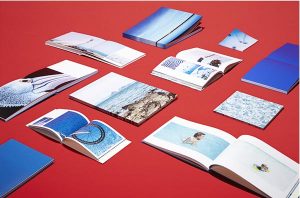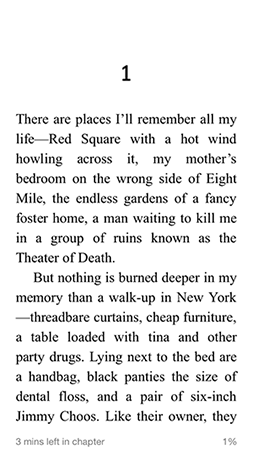Archive for the ‘E-Books & Publishing’ Category
by Ella at Bob Books
The medium of photography has often become far too disposable, our pictures stored on digital platforms rather than in a format we can hold, pass around and display.
Bob Books was founded in order to solve the problem of the disappearance of this magical art form — allowing you to create your very own photo book. You can bring your memories to life: use your images and tell your story.
My favourite Bob Book this year, which won the Bob Books Photo Book of the Month competition in February, has got to be ‘Travels with My Father’ by Thomas North. Here, a son created a visual diary for his father of their travels to Australia and Japan. Their journey is moving and full of life as he captures both their surroundings and their bond, perfectly.
For the past 10 years Bob Books has established itself as the most well-loved and trusted platform for creating, printing and publishing photo books in the UK. Bob Books is used by countless professional and aspiring photographers, who understand that photographs can easily be transformed into keepsake objects with just a moment of inspiration.
As the UK’s top supplier of photographic paper photo books; our best-selling, lay-flat, photographic paper books are produced using a silver halide photographic process. Images are exposed onto 300gsm photographic paper and then developed through traditional chemical photographic processes. The pages are then bound using our unique lay-flat binding, displaying double page spreads at their best. Our product range includes hardback and paperback books and boasts a wide range of papers and finishes, all of the highest quality. We even offer logo-free printing for free.
Using the easy Bob designer software, PDF to book or simple drag-and-drop app for the iPad, Bob Books gives you the opportunity to make a customized, beautifully crafted photo book (suited to every design ability).
Once ordered, you can then choose for the book to be published in the Bob Bookshop, an exciting platform for people to share and sell their creations.
And now, Bob Books is offering a 15% discount to all fotoLibra customers!
Make the most of your collections of archival images or family photos and turn them into an object of beauty.
Wherever your passion lies, your pictures can tell a beautiful story.

African Fish Eagle in Flight
Take advantage of this today by visiting www.bobbooks.co.uk/fotolibra to quickly claim your discount and get started!
Picture credits: Selection of Bob Books © Bob Books | Bob Books spread © Bob Books | Galloping horse © Paul Richards / fotoLibra | Palmyra, Syria © Paul Gapper / fotoLibra | Krak des Chevaliers © Bernard O’Kane / fotoLibra | African Fish Eagle in Flight © Linda Wright / fotoLibra
Gwyn writes: Bob Books is owned by an old friend of mine who works to the highest possible standards. Give them a go — you won’t regret it. And if the pictures illustrating this guest blog look familiar, it’s because they’ve been chosen from the fotoLibra archive.
I Am Copy Editor
October 14th, 2014by Gwyn Headley
Managing Director
Tags: American, copy editor, e-books, ebooks, English, I Am Pilgrim, Terry Hayes
During the Frankfurt Book Fair, just past, my bedtime reading was an ebook, a thriller recommended to me by Yvonne: I Am Pilgrim by Terry Hayes, whose name, bafflingly, does not appear on the cover. It’s a rollicking and undemanding read, so I recommended it to my friend and travelling companion Mike Shatzkin, who immediately bought and downloaded it.
I had been complaining of the poor editing quality of most ebooks — the Copy Editor, diligently scanning for literals, is now an extinct species in the wild — and I Am Pilgrim hits you in the first line, with a Beatles quote and a mistake:
“THERE ARE PLACES I’ll remember all my life — red square with a hot wind howling across it …”
Such a shame that people don’t seem to be bothered any more. If you know enough about style to start a chapter with the first three words in small caps, then surely you’ll know that ‘red square’ should be ‘Red Square’ — and your copy editor should be on to it like a vat of hot metal.
Mike’s version was published by Emily Bestler Books, an imprint of Simon & Schuster, whereas my British version was published by Transworld, owned by Penguin Random House. Entirely separate companies, one in America, one in the UK.
Nevertheless the fact that they didn’t exchange digital files for the ebook and each created their version from scratch somewhat surprises me. “Keep the change” is not a frequent phrase in my vocabulary, but this seems like a wanton waste of money.
Mike said “What’s the problem with Red Square? It looks OK to me.” And in his version — the American edition — it was.
The troubling thing for me is that the American typesetting is more correct than the British version. Here they are, so you can compare them:
BRITISH vs AMERICAN
Chapter One vs 1
FIRST THREE WORDS in small caps vs First three words in U/LC
space dash space vs em-dash
red square vs Red Square
8-Mile vs Eight Mile
Theatre vs Theater
burnt vs burned
Choo’s vs Choos
and I’m sure there will be examples on every page, but you get the drift.
Two nations separated by a common language, indeed.
When Is A Book Not A Book?
July 18th, 2013by Gwyn Headley
Managing Director
We had a mailshot from the Frankfurt Book Fair yesterday.
It said “Deutsches Architekturmuseum (DAM) and the Frankfurt Book Fair are this year asking again for entries to be submitted for the DAM Architectural Book Award 2013. All art and architectural book publishers worldwide are invited to do so.”
Excellent, I thought. Our profusely illustrated Heritage Ebooks will be just the ticket, and will get us some much needed publicity — and maybe some sales as well.
But apparently not.
My proposal was curtly answered: “I am sorry but online publications are not to be considered.”
Well, they are not online publications. They are ebooks, in Kindle and EPUB formats. The titles are not available in print format, as the Active Location Finder we use to physically locate the buildings described in the books can only work in an ebook.
So I told them. Now they have sent us a holding letter while the Deutsches Architekturmuseum and the Frankfurt Book Fair deliberate as to whether an ebook can be regarded as a book.
Should I be holding my breath?
Contentious VAT On Ebooks
October 28th, 2012by Gwyn Headley
Managing Director
Tags: 3G, accountants, Amazon, American, Apple, bandwidth, Berwin Leighton Paisner, BLP, British publishing industry, broadband, City, clients, digital publishing, drive prices down, ebooks, Europe, fiscal neutrality, Foyles, gilt-edged, Government, greater good, Heritage Ebooks, HMRC, illustrated ebooks, KFC, law, lawyers, losing, Luxembourg, Macdonalds, photographers, picture libraries, Printed books, pro bono, Publishers, raise prices, standard-rated, Starbucks, tax, Tesco, UK, VAT, Waterstones, zero-rated
Printed books are zero-rated for VAT in the UK. Ebooks are taxed at 20%.
Publishers have taken a softly-softly approach to VAT on ebooks, fearful that if they kick up too much of a fuss the Government will awaken to the fact that printed books are presently zero-rated and slap 20% on them overnight.
Such a move would decimate the British publishing industry — and by extension picture libraries, photographers and all the industry’s ancillary suppliers would take a huge hit. It’s therefore unlikely to happen, but who can predict what a politician may take into his head to do.
City law firm Berwin Leighton Paisner has announced on its website:
“VAT treatment of ebooks – The firm is taking a groundbreaking case challenging HMRC’s view that ebooks are standard-rated for VAT purposes, in contrast with physical books which are zero-rated.”
Hard-nosed commercial firms like BLP do not take cases on pro bono, or challenge national or international law simply for the greater good. Therefore they’re doing this for one of their clients, and that client will have deep, deep pockets.
Who can it be? Who will benefit?
Well, the consumer will benefit if prices fall by 20% (they won’t). Publishers will benefit from a boost in sales.
But by far the biggest beneficiaries will be the retailers. Apple sells ebooks. Tesco sells ebooks. They will both see a hike in profits. BLP numbers Apple and Tesco among its gilt-edged list of clients.
Our digital publishing company Heritage Ebooks sells 50 illustrated ebooks from its site for every one ebook sold by the rest of the UK’s ebook sales outlets — Waterstones, Foyles, Tescos and so on — put together.
And for every one of our ebooks that we sell from our site, Amazon will sell twelve from theirs.
It is disproportionately huge. OK, so we’re tiddlers, microbes even, but I expect the proportions are similar whatever you publish.
Amazon has been subject to much opprobrium and contumely for selling ebooks to UK customers and charging the full 20% VAT while taking advantage of the 3% VAT they pay as a company based in Luxembourg. Like Starbucks, Macdonalds and KFC, large American companies have an aversion to paying their fair share of tax in Europe, and as their lawyers and accountants are sharper than ours, they can get away with it.
And now some organisation, through BLP, is challenging HMRC’s ruling on the grounds that charging different rates of VAT on print books and ebooks breaches EU law on fiscal neutrality.
Come on, this has to be Amazon. Who else could afford such a suit? And who else would profit more?
Amazon charge us, the publisher, for the bandwidth used when a customer buys and downloads a Heritage Ebook from them. Because our ebooks are highly illustrated, they have large filesizes and therefore incur high bandwidth usage fees. And because one or two books are downloaded via 3G rather than broadband, Amazon charges us across the board at mobile phone companies’ bandwidth fees.
The result is that for two of our titles, we are losing 10p on every sale made through Amazon because of their charges. Amazon are thereby forcing us to raise our prices.
And I thought their intention was to drive prices down.
Illustrated Ebooks: A View From The Coal Face
August 7th, 2012by Gwyn Headley
Managing Director
First, some housekeeping. We’ve had teething problems with an email server since last Friday. It’s fixed now, but if you’ve recently contacted fotoLibra and haven’t yet had a reply, please send your message again. Thanks, and apologies.
I was prompted to write this after reading a posting about the subject on Mike Shatzkin’s invariably thought-provoking blog. Shatzkin leans more towards pessimism than I do. But he thinks carefully, deeply and analytically before he puts fingers to keyboard and what has has to say is always worth listening to.
He pleaded “Somebody please tell me the path to survival for the illustrated book business.” He meant illustrated ebooks, of course.
OK, this is the view I’m getting from where I’m standing. I admit you can’t see very far when you’re staring at the coal face, but if our sole purpose was to make money out of illustrated ebooks in the next 12 months, a) we’d have chosen a different subject, such as porn, and b) we probably wouldn’t have started to dig the mine.
There’s no denying that the sales of Heritage Ebooks’ first 40 illustrated titles have been less than spectacular. I would go so far as to describe them as disappointing. But all publishers are optimists by nature, and what gives me hope is that having created the books, they now are sitting in virtual warehouses at no cost to us, as ready and available for sale to your device today as they will be in five years time.
It is very true that the market hasn’t yet evolved for the illustrated ebook. We are seeing sales in ones and twos. But when people have grasped the concept, they have committed themselves wholeheartedly. So far seven of our customers have ticked the two most important boxes — they are interested in the subject we’re publishing, and they are comfortable with digital reading, and as a result they have bought thirty or more ebooks from our Follies of England series. Two have purchased all forty titles.
Heritage Ebooks is constrained by geography and field of interest. If you’re not interested in follies and you don’t often get to England, then we are not your kind of epublisher — at the moment. We have more titles on other topics planned; an illustrated tour of every Spanish province, a parenting guide; but for the moment we are cornered in a niche market.
Amazon’s hegemony isn’t particularly helpful. To build market domination, they gathered low-hanging fruit in bushels — bestselling fiction. The Kindle is designed for reading plain text, not illustrated books. 16 shades of grey may have inspired a bestseller, but it’s not a turn-on for illustrated ebook publishers. The colour Kindle Fire hasn’t yet got a release date in the UK.
Nevertheless Amazon sell eleven times as many of our ebooks as all our other sales outlets, including our own heritage.co.uk website, put together. Our return from them is feeble. Our ebooks are heavily illustrated, so they have large file sizes. Amazon charges us, as publishers, for their bandwidth used when a purchaser downloads a copy of one of our ebooks. If it’s a £4.99 ebook, that can be as much as 80p per title. Remember that comes after VAT and KDP’s 30% fee has been taken off.
Our choice to publish ebooks using Epub was driven by a number of factors. Foremost was Heritage Ebooks’ position as a sister company of the picture library fotoLibra.com. Pricing images for digital use was posing problems for us as the foundations for calculating the great majority of prices — print run and image size — had been removed at a stroke. We wanted to provide a system which would work for us, for our photographers and for digital publishers. We created advanceImages, a microroyalty system with no upfront fees, so epublishers could use as many images as they liked without any cashflow worries before publication. After six months sales, the publisher submits the retailers’ sales reports and is billed a royalty on the images used. Clearly no one was going to play guinea pig, so we set up our own publishing division to demonstrate the service’s functionality. To that extent Heritage Ebooks has been a tremendous success — the system works, and works well. The first advanceImages royalty statements will be posted with the launch of fotoLibra Version 5.0, hopefully next week.
Another incentive was to display our Active Location Finder, a mapping system which displayed both the reader’s location and the precise position of the building described, a tremendous asset to any ebook guide publisher. This is simply impossible to do in a conventional printed book, and it was another spur to creating our first illustrated architectural guide books.
A third was graphical: graphics, typography, design, subjects that were embedded in me from my earliest days in publishing, suddenly became irrelevant. I find it incomprehensible that Fifty Shades of Grey can be presented in the same Caecilia font as Bring Down The Bodies, Harry Potter or this week’s Jack Reacher story. To me each font has its own unique voice, accent and point of view. Using the same font for everything you read is like listening to Churchill’s speeches being spoken by a computer.
Heritage Ebooks were created with the iPad as its preferred reading device. There was sufficient screen real estate to display images well, better in fact than in most physical books. We wanted reflowable and resizable text which would stay with the images it referred to. And although we couldn’t force readers to use our font choice of Cochin, at least we could recommend it. Then came iPad 2, and Cochin disappeared from the selection of fonts available. It has returned for iPad 3.
The future? More people will read illustrated ebooks on more devices. No, printed books will not disappear. It’s uncertain whether illustrated ebooks will take market share from illustrated books, or create a new segment. When automatic transmission was first introduced for cars in 1940 it was widely seen as the death knell for the stick shift. Yet over 70 years later in Europe, the world’s most sophisticated car market, over 80% of new car buyers choose manual transmissions. Even in America, home of the Wafter, sales of manual shifts are on the increase. Easier isn’t always better or more popular. We will have printed books alongside ebooks, which will have to have additional features (I refuse to use the word enh*nc*d) to recommend them to a separate but similar market.
Yes, the first forty Heritage Ebooks have cost us more than they have made so far. But they are out there in the marketplace, they look great, they work perfectly, and we have learned useful lessons, and we have proved the efficacy and worth of fotoLibra’s advanceImages system to the benefit of photographers and publishers alike. We’ll be publishing more. There are no remainders in this business.
Consumables, Landfill, Heirlooms
June 25th, 2012subtitled CONTENT vs DEVICES
I wish I knew what it was about the human condition that makes people like me pant after shiny things, wide aperture lenses and items with plugs.
Take ebooks. The Kindle is easily the market leader, but there are people who swear by Nook or Kobo, or who would only read ebooks on an iPad.
Now imagine that you had to make the decision that you would only read books printed by collotype. Or gravure. Or having a sulk because your partner prefers letterpress to litho.
It’s irrelevant. You know it is. I know it is. It’s the same with cameras. Once the short, bloody war between film and digital had been comprehensively won, the same old rivalry continued between the Nikon and Canon camps.
It. Doesn’t. Matter.
You can read Hilary Mantel’s Bring Up The Bodies as a book, on a Kindle, on a Nook, on an iPad, on your Android ’phone if you will.
You can admire a Colin Macpherson photograph in print, on your laptop or on your iPhone.
It. Doesn’t. Matter.
It’s whatever you feel most comfortable with. The tools used to create and convey the work are unimportant. What matters is the mind and eye that controls that tool. It’s the brain that creates the content, whether it be Wolf Hall or an Ansel Adams print.
Some artists fall in love with their tools (OK, I could have phrased that more elegantly) like Douglas Adams, who obsessed about his Apple Macs. Others will write with whatever comes to hand (this gets worse). The creator will use whatever he or she is most comfortable with, and it should be the same for the consumer. Don’t feel pressured into abandoning printed books if that’s what you like best. I’m not going to recommend reverting to film cameras, however, because whatever happens you will have to digitise that image at some point. It may as well be born digital. But how will you bear to be reading a book on an iPad One when the 12-year-old sitting next to you on the tube is perusing an iPad Three?
The device is important of course, but the method of delivery is far less important than the actual content. It is infinitely more agreeable to get to the Frankfurt Book Fair by Rolls-Royce than by bus — but the important bit is getting to Frankfurt.
When you finish A La Recherche du Temps Perdu people aren’t going to ask you whether you read it in hardback, paperback or as an ebook, though they may ask if you read it in French or in translation. When you eat a meal, you needn’t ask the cook what oven she uses, especially if you plan on using teeth to eat with in the future. Why then do people say “Lovely photograph. What camera do you use?”
It. Doesn’t. Matter.
Everything you and I buy can be placed in one of three categories:
Consumables: e.g. Food. I eat it. I buy more. Clothes. I wear them. I wear them out.
Landfill: e.g. anything with a plug. If such a remarkable device as an iPad had existed in 1979 when I bought my Mont Blanc pen for £30, it might have cost a million pounds. Today they both cost about £500. In ten years’ time my pen will be worth about £750 and I will have thrown away my iPad. All the ebooks I bought will probably be irretrievable.
Heirlooms: e.g. my pen. I write with it. I will write with it for the next 20 years. Then I will leave it to a niece. It will always be worth more than I paid for it. And the leather bound copy of Follies will be on my bookshelf when I am cold and dry.
The memories of the marvellous books I have read and the wonderful photographs I have seen will stay with me long after the tools that produced them have been consigned to the scrap heap.
Heirlooms.
Content.
The Feminisation Of Marketing
April 20th, 2012by Gwyn Headley
Managing Director
… or Feminization if you’re American.
At the Digital Minds Conference last Sunday, part of the London Book Fair (from which I’ve only just surfaced, so please excuse the tardiness of this thought) there were three keynote speakers. I’d always thought there could only be one keynote speaker, who would be The Keynote Speaker, but the conference world appears to have left me behind. Or common sense has left them behind.
One of the excellent keynote speakers (there were two) was Jim Griffin of OneHouse LLC. I didn’t know him or what he does, but I listened obediently. And what he had to say was good. I sat up when he announced “Every time someone has to click on your website, you lose half your audience.”
Of course you do! I do it myself! Like most youth, I suffer from diminishing attention span syndrome, and if I find a website is making too many demands on me, I will wander off elsewhere. Memo to self: must ensure that the new iteration of fotoLibra has as few jumps as possible. There’s a great art in this, and for someone as prolix, verbose and effulgent as I am, it is extremely hard to pare what I want to say back to the core. E.g. that 32 word sentence could have been written in seven.
Griffin went on to advocate the feminisation of marketing. In a few swift sentences he describes the shift from the Alpha Male marketing of the late C20 to today’s softer, more insidious techniques. And he’s absolutely right. Ten years ago companies would unblushingly describe their salesmen as ‘thrusting’, ‘aggressive’, ‘potent’ and displaying a ‘robust’ attitude. They might have well as stated their policy as “Wham! Bang! Thank you Ma’am!” Make the sale, move on. Scored! Or as I saw in one memorable, boastful but educated piece of grafitti: VIDI • VICI • VENI ( you can look it up for yourselves if you need to).
When I interviewed Jeff Bezos for The Times back in 1996 he told me that he’d chosen the name Amazon for his company because he wanted it to be the biggest damn retailer in the world and the Amazon was the biggest damn river. It seemed like braggadocio at the time, but they’re on their way. And they’ve done it through the feminisation of their marketing, not through the big swinging dick statements of their founder.
Jim Griffin pointed out that Amazon knows what you like to read. It knows your birthday. It knows the sort of music you listen to, the films you watch. It probably remembers the colour of your eyes and your wedding anniversary. It’s a woman, for God’s sake. And the customers keep coming back. Amazon isn’t interested in a one night stand, it wants a long term, loving relationship. As long as you keep giving it money.
What if you go off and start buying from someone else? I wouldn’t be surprised to learn that in the future there’ll be some built-in module to penalise disloyalty.
They could call it Alimony.
Join the Conversation
April 11th, 2012by Gwyn Headley
Managing Director
This Sunday, as part of the London Book Fair, the Digital Minds Conference will be held at the Queen Elizabeth II Conference Centre in Westminster, London.
The organisers have told us to get there in good time because public transport in London sucks on a Sunday. In fact the real reason is because security at the Queen Elizabeth II Conference Centre is so paranoid it will take you as long to get into the building as it takes an innocent Brit to get into the United States via JFK. Last time I visited I thought I saw the words “anal probe” being mouthed by the security guards. I vowed never to go again.
But all the leading lights of the ebook world will be there (if they’re allowed in), so attendance is virtually compulsory. Many sessions and seminars are taking place. Bill McCoy, the Director of the International Digital Publishing Forum (they create and maintain the EPUB ebook format, the standard for ebooks) is chairing one session called Join the Conversation – Digital Platforms and Standards. This consists of round table conversations on a wide range of topics steered by industry ‘experts’, with three subject sessions and approximately 18 different tables covering a variety of angles.
The reason I put ‘experts’ in quotes is that I am one of them — my table theme is Photographic and Illustrated Ebooks. This will be an informal round table discussion with 12 people on the design, production, marketing and future of illustrated ebooks. You are welcome to join in. I’ve been asked to host this as a result of the publication of our first forty ebook titles by VisConPro’s digital publishing arm, Heritage Ebooks.
There are over 1,900 photographs in Heritage Ebooks’ Follies of England series, the majority provided by talented fotoLibra photographers. It is the biggest digital heritage ebook project ever published. And we created it to demonstrate a new method of visual content provision to digital publishers, fotoLibra’s advanceImages system.
Now we have a chance to sit down with other digital publishers and talk through what we did and how it works. It’s a great opportunity for us. And I hope it will prove useful for participants.
If you can’t run to the conference fee of £399, I’ll be happy to meet with digital publishers for free at the London Book Fair next week. We’re on Stand T905, through the kind courtesy of our hosts Publishers’ Marketplace.
Heritage Ebooks — the first fortnight
November 8th, 2011by Gwyn Headley
Managing Director
Heritage Ebooks, for those who don’t know, is the digital publishing arm of VisConPro Ltd, the holding company of fotoLibra. So we’re sister companies: same owners, same shareholders, same staff.
We set up Heritage Ebooks to demonstrate the advanceImages system for supplying images to ebook publishers, and it’s already taken on a life of its own. I will be blogging extensively about advanceImages next month.
Heritage Ebooks’ first 40 titles are the Follies of England series, over a quarter of a million words written by me and Dutch art historian Wim Meulenkamp, and with a large percentage of the 1,900+ photographs taken by fotoLibra members. You can see our first titles here at heritage.co.uk — click on VIEW ALL TITLES.
Although we’re not awash with critical acclaim — nobody has yet reviewed a single title — there has been media interest. I was on BBC Radio 4′s flagship programme Today on Monday 31 October, talking about follies.
Today the Daily Mail ran a good, big feature on the amazing follies of Whitaker Wright, with a credit to Heritage Ebooks at the end. You can read it here.
All this, as our PR says, is grist to the mill. fotoLibra members are being paid a royalty on the sale of these books, so the more books we sell, the more they will earn. And ebooks never go out of print. So the money will keep coming in. More publicity means more sales. To date we’ve sold 99. Harry Potter this isn’t.
But it’s a start.









